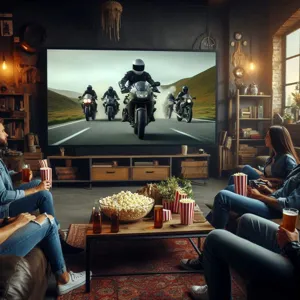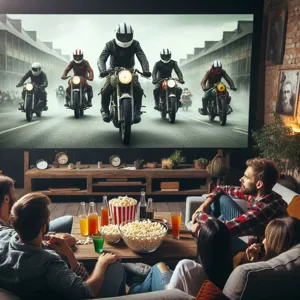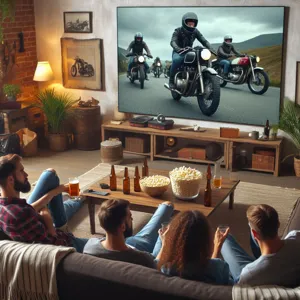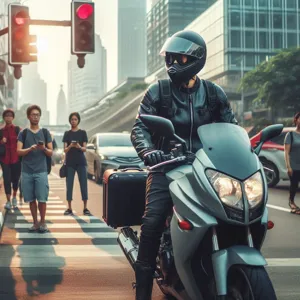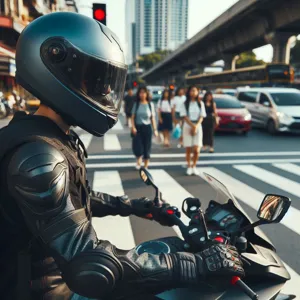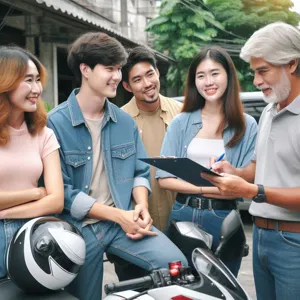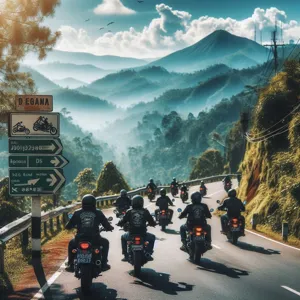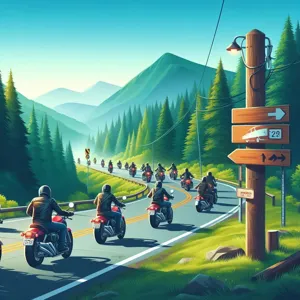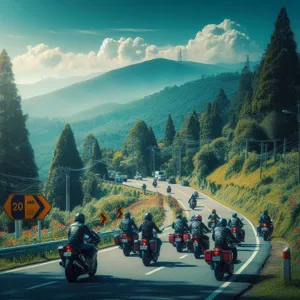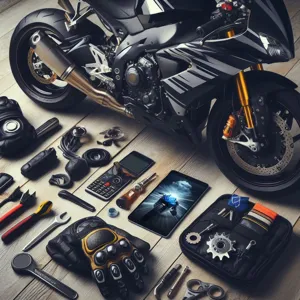For motorcycle enthusiasts, the thrill of the open road is more than just a pastime; it’s a way of life.
Whether you’re a seasoned rider or just starting to explore the world of two wheels, having access to the right information and inspiration can elevate your riding experience to new heights. With a myriad of motorbike blogs and websites available, it can be overwhelming to find the best sources that resonate with your passion for biking. In this blog post, we’ll rev up your engines by showcasing the top motorbike blogs and websites that offer invaluable insights, expert reviews, and captivating stories from fellow riders. From maintenance tips and gear recommendations to travel adventures and community happenings, these platforms are sure to fuel your passion for motorcycling and ignite your wanderlust. So gear up, as we take you on a journey through the digital landscape of motorbike culture!
1. Introduction to the World of Motorbiking

The thrill of the open road, the rumble of a powerful engine, and the freedom that comes with the wind in your face—motorbiking is more than just a mode of transportation; it’s a lifestyle and a passionate community. From the winding backroads to the bustling city streets, the world of motorbiking offers endless opportunities for adventure and personal expression. Whether you’re a seasoned rider or a curious newcomer, there’s something undeniably magnetic about the world of two wheels.
In this realm, each biker has their own unique story, often woven together by shared experiences and the camaraderie that comes with being part of a global tribe. Riders embrace the exhilarating feeling of independence while discovering breathtaking landscapes and hidden gems along the way. Motorbiking is not just about the journey; it’s about connecting with fellow enthusiasts, sharing tips and tricks, and finding inspiration in the tales of others who share your passion.
As you delve into this blog post, you’ll discover an array of top motorbike blogs and websites that cater to every aspect of riding—from maintenance and modifications to travel tips and gear reviews. These resources not only keep you informed about the latest trends in the motorbike industry but also ignite your enthusiasm for the road ahead. So, gear up and get ready to explore the rich tapestry of motorbiking culture, where every ride tells a story and inspires the next adventure.
2. Why Follow Motorbike Blogs?
The world of motorbiking is not just about the thrill of the ride; it’s also about the community, the culture, and the wealth of knowledge that comes with it. Following motorbike blogs can significantly enhance your experience, whether you’re a seasoned rider or a novice just starting to rev your engine. But why should you make it a priority to keep up with these online resources?
Firstly, motorbike blogs are rich sources of information. They provide in-depth reviews of the latest models, gear, and accessories, helping you make informed decisions before purchasing anything. From expert opinions on performance to user testimonials, these blogs cover it all, offering insights that you may not find in standard advertisements or product descriptions.
Moreover, motorbike blogs foster a sense of community among riders. They often feature personal stories, adventures, and challenges faced by fellow bikers, creating a relatable space where you can share your own experiences and learn from others. This camaraderie is invaluable, as it connects you with like-minded individuals who share your passion for two wheels.
Additionally, many blogs delve into the technical aspects of motorcycling, offering tips on maintenance, riding techniques, and safety precautions. Whether you’re looking to improve your skills or keep your bike in top condition, this knowledge is essential. Following these blogs ensures you’re up-to-date with the best practices and innovations in the industry.
Lastly, motorbike blogs often highlight events, rallies, and rides happening in your area or around the globe. This can help you discover new opportunities to meet fellow enthusiasts, participate in group rides, or attend motorcycle expos. By staying connected through these blogs, you’ll never miss out on the latest happenings in the motorbike community.
In essence, following motorbike blogs isn’t just about gaining knowledge; it’s about immersing yourself in the culture of motorcycling, enhancing your riding experience, and connecting with a vibrant community. So, if you haven’t already, it’s time to hit that subscribe button and let the inspiration flow!
3. Criteria for Selecting the Best Blogs

When it comes to finding the best motorbike blogs and websites for inspiration and insights, there are a few key criteria to consider. The vast digital landscape is filled with countless blogs, but not all are created equal. Here are the essential factors to guide you in selecting those that resonate most with your passion for motorbiking.
**1. Expertise and Authority:** Look for blogs authored by experienced riders, industry professionals, or enthusiasts who have a deep understanding of motorbikes. Expertise can often be gauged by the author’s credentials, the quality of the content, and the depth of knowledge displayed in their writing. Blogs that feature guest posts from industry experts also add an extra layer of credibility.
**2. Content Quality:** The best motorbike blogs offer high-quality, engaging, and informative content. Look for sites that provide in-depth reviews, detailed how-to guides, and captivating stories from the road. Well-researched articles, stunning photography, and attention to detail can significantly enhance the reading experience and provide valuable insights.
**3. Niche Focus:** The motorbike world is diverse, with various niches such as touring, adventure riding, racing, and vintage restoration. Depending on your interests, you may want to seek out blogs that specialize in your preferred niche. A focused blog is more likely to provide tailored advice and relevant information that aligns with your specific motorcycling pursuits.
**4. Community Engagement:** A thriving blog often comes with a vibrant community. Check for active comment sections, social media interactions, and forums associated with the blog. Engaging with other readers and the blog’s authors can enhance your experience and provide a sense of belonging within the motorbike community.
**5. Regular Updates:** The best blogs are consistently updated with fresh content. A blog that has not been updated in months might indicate a lack of commitment or relevance. Look for sites that post regularly, as this ensures you have access to the latest trends, news, and insights in the ever-evolving motorbike landscape.
**6. User-Friendly Design:** A well-designed website enhances usability and can make a significant difference in your experience. Look for blogs that are easy to navigate, visually appealing, and mobile-friendly. A clutter-free design allows you to focus on the content without being distracted by unnecessary elements.
By considering these criteria, you can curate a personalized list of motorbike blogs and websites that not only inspire you but also provide essential insights to fuel your motorcycling journey. Whether you’re seeking technical advice, travel inspiration, or community connections, the right blogs can elevate your riding experience to new heights.
4. Top Blogs for Motorcycle Reviews
When it comes to making informed decisions about purchasing a new motorcycle or upgrading your existing ride, reading comprehensive reviews is essential. The right blog can provide you with in-depth insights, expert opinions, and firsthand experiences that go beyond manufacturer specifications. Here are some of the top blogs that excel in motorcycle reviews, offering valuable information for both seasoned riders and newcomers alike.
**1. Motorcycle.com**
Motorcycle.com is a staple in the motorbike community, featuring an extensive library of reviews covering everything from cruisers to sportbikes. Their team of experienced riders puts each bike through rigorous testing, providing readers with detailed performance evaluations, pros and cons, and comparisons to rival models. The user-friendly format makes it easy to find reviews based on your specific interests, whether you’re in the market for a touring bike or a nimble naked bike.
**2. RevZilla**
RevZilla is not just a retailer; it’s a treasure trove of motorcycle content. Their video reviews are particularly noteworthy, blending visual appeal with informative commentary. The team’s passion for motorcycles shines through as they discuss features, technology, and riding experiences, making it easy for viewers to grasp the nuances of different models. Their extensive database ensures that you’ll find reviews on both the latest releases and beloved classics.
**3. Cycle World**
A long-standing authority in the motorcycle world, Cycle World offers a blend of editorial content and reviews that cater to a diverse audience. Their comprehensive reviews often include expert analysis and a historical context that enriches the reader’s understanding. Additionally, they provide comparisons and buyer’s guides that help riders navigate the vast array of choices available in the market.
**4. Motorcyclist**
Motorcyclist has been delivering motorcycle news and reviews for over a century. Their reviews are known for their depth and detail, often accompanied by stunning photography that captures the essence of each bike. They also feature long-term tests, allowing readers to understand how a motorcycle performs over time, which is invaluable when considering a purchase.
**5. BikeWale**
For those looking for reviews that cater to the Indian motorcycle market, BikeWale is the go-to resource. Their user-generated reviews provide real-world insights from fellow riders, complemented by expert evaluations that cover both performance and usability. With a focus on affordability and practicality, BikeWale helps riders make informed decisions based on their unique needs and preferences.
With these top blogs at your fingertips, you’ll be well-equipped to dive into the world of motorcycles armed with expert insights and comprehensive reviews. Whether you’re seeking the latest performance metrics or comparing options, these resources will help you rev up your knowledge and make confident riding choices.
5. Best Blogs for Rider Tips and Safety

When it comes to hitting the open road, knowledge is just as important as the motorcycle beneath you. The right tips and safety advice can make all the difference between a thrilling ride and a perilous one. Thankfully, the world of motorbike blogging is rich with resources dedicated to empowering riders with the information they need for a safe and enjoyable experience. Here are some of the best blogs you should check out for rider tips and safety insights:
1. **Motorcycle Safety Foundation (MSF)**: As a leading authority on motorcycle safety education, the MSF blog is a treasure trove of information. It covers everything from basic riding techniques to advanced safety strategies, ensuring riders of all skill levels can enhance their knowledge. With in-depth articles that often include expert interviews, the MSF blog emphasizes the importance of training and awareness on the road.
2. **RideApart**: This popular motorbike blog delves into various aspects of motorcycle culture, but its safety section is particularly noteworthy. RideApart features practical advice on gear selection, maintenance tips, and crash prevention strategies. The engaging writing style and community-driven discussions make it a go-to destination for riders looking to improve their skills while connecting with fellow enthusiasts.
3. **RevZilla’s Common Tread**: Known for its extensive range of motorcycle gear and accessories, RevZilla also offers an insightful blog called Common Tread. Their rider safety category is packed with articles that focus on gear reviews, accident prevention, and road awareness. The blend of personal anecdotes and expert advice creates a relatable and informative resource for riders seeking to stay safe on their journeys.
4. **Motorcycle.com**: A hub for all things motorcycle, Motorcycle.com features a dedicated section for safety tips and riding advice. Their articles cover everything from the best practices for new riders to insights into handling challenging weather conditions. The blog often includes contributions from seasoned riders, making it a reliable source for practical and relatable advice.
5. **The Ride Apart Safety Blog**: This subset of the RideApart site focuses exclusively on safety tips and guidelines. Here, you’ll find articles that address specific scenarios, such as riding at night or navigating through heavy traffic. The blog emphasizes the importance of mental preparedness and situational awareness, helping riders develop a comprehensive approach to safe riding.
By tapping into these blogs, you’ll not only enhance your riding skills but also cultivate a deeper understanding of motorcycle safety. Whether you’re a seasoned rider or just starting your journey, the wisdom shared on these platforms will keep you informed, inspired, and ready to conquer the road ahead with confidence.
6. Inspirational Blogs from Long-Distance Riders
Long-distance riding is a unique adventure that combines the thrill of the open road with the challenges of endurance and exploration. For those seeking inspiration and insights, there are several remarkable blogs authored by seasoned riders who have traversed continents, encountered diverse cultures, and faced the unpredictability of the elements. These blogs offer not just travel tales, but also invaluable tips and advice that can enhance your own riding experience.
One standout blog is **”The Adventure Rider”**, where the author shares tales from their epic journeys across rugged landscapes and bustling cities alike. With stunning photography and engaging storytelling, they capture the essence of what it means to be a long-distance rider—embracing both the joys and the tribulations of life on two wheels.
Another gem is **”The Moto Nomad,”** where tales of solo rides through remote terrains and detailed gear reviews blend seamlessly. This blog serves as a treasure trove of practical advice, from packing essentials to navigating through less-traveled paths. The author’s experiences resonate with both novice and experienced riders, encouraging them to embark on their own adventures.
For those who seek camaraderie in their travels, **”Two Wheels, One World”** offers a unique perspective with contributions from a community of long-distance riders. Their stories of friendship and shared experiences on the road remind us of the bonds that form through shared passion.
Lastly, **”Long Way Round”** revisits the iconic journey taken by Ewan McGregor and Charley Boorman. This blog not only reflects on their adventures but also inspires readers to pursue their own long-distance dreams, proving that the world is vast and waiting to be explored.
These blogs are not just about the miles traveled; they encapsulate the spirit of exploration, resilience, and the unyielding love of motorbiking. Whether you are looking for tips on your next journey or simply seeking the thrill of adventure through someone else’s narrative, these long-distance rider blogs will surely fuel your wanderlust and inspire you to hit the road.
7. Best Custom Bike Build Websites
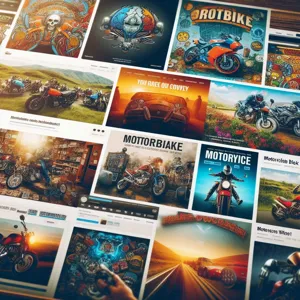
When it comes to custom motorcycle builds, the online landscape is rich with inspiration, expertise, and a vibrant community of enthusiasts eager to share their knowledge. The best custom bike build websites not only showcase jaw-dropping transformations but also offer in-depth guides, tutorials, and insights into the art and science of motorcycle customization.
One standout site is **Bike Exif**, renowned for its curated gallery of custom bikes from around the globe. Each feature delves into the specifics of the build, highlighting the craftsmanship and unique elements that set each motorcycle apart. From classic cafe racers to modern choppers, Bike Exif serves as a treasure trove for those seeking inspiration or simply appreciating the beauty of custom design.
Another excellent resource is **The Bike Shed**, which offers a blend of stunning bike builds and a community atmosphere. With its engaging blog posts and vibrant forum, The Bike Shed is a hub for riders to share their projects, swap tips, and connect with like-minded individuals. The site also hosts events that bring together custom bike lovers in a celebration of creativity and passion.
For those looking for hands-on guidance, **Custom Motorcycle Builds** is a must-visit. This site is dedicated to providing practical information, including step-by-step instructions on everything from engine modifications to paint jobs. With detailed articles and video tutorials, it empowers enthusiasts to take on their own projects with confidence.
Finally, **Chopper Journal** is a go-to for anyone who appreciates the raw aesthetic of chopper culture. Featuring not just builds but also the stories behind them, this site captures the spirit of the ride. Readers will find interviews with builders, gear reviews, and a plethora of eye-catching images that fuel the desire to hit the road on a one-of-a-kind machine.
Dive into these top custom bike build websites to unlock a world of creativity and innovation that will not only inspire your next project but also connect you with a community that shares your passion for motorbikes. Whether you’re a seasoned builder or just starting, these resources are invaluable in helping you rev your engine and embark on an exciting journey of customization.
8. Blogs Focused on Women in Motorcycling
The world of motorcycling has historically been dominated by a male-centric narrative, but in recent years, a dynamic shift has emerged with the rise of blogs and websites that celebrate and empower women riders. These platforms not only provide insights into the unique experiences and challenges faced by female motorcyclists but also foster a strong sense of community and camaraderie among women who share a passion for the open road.
One standout blog is *Women Riders Now*, which serves as a comprehensive resource for women interested in motorcycling. From gear reviews tailored to female riders to travel stories that inspire adventure, the site covers a wide array of topics that resonate with its audience. Their engaging articles often feature profiles of women who have broken barriers in the industry, showcasing their journeys and the diverse paths they’ve taken.
Another noteworthy site, *MotoLady*, is a vibrant hub for female bikers that combines fashion, lifestyle, and riding culture. With a focus on empowerment, the blog highlights women in the motorcycle community through interviews, event coverage, and insightful content that encourages women to embrace their individuality while riding. Its visually appealing layout and strong social media presence make it an inspiration for those seeking to connect with fellow female riders.
Additionally, *The Bike Shed* offers a section dedicated to women in motorcycling, featuring stories of female riders who are making their mark in a traditionally male-dominated field. This blog emphasizes not just the experience of riding, but also the sense of belonging that comes from being part of a supportive community.
For those looking to explore the world of motorcycling from a female perspective, these blogs are excellent resources filled with motivation, advice, and insights. By engaging with this content, women can find inspiration not only for their riding journeys but also for their identities as confident and skilled motorcyclists. Whether you’re a seasoned rider or just starting, these platforms remind us that the open road is meant for everyone—each ride a testament to freedom, adventure, and empowerment.
9. The Best Adventure Riding Blogs
Adventure riding is a thrilling way to explore the world on two wheels, and the best adventure riding blogs capture the spirit of exploration, camaraderie, and the sheer joy of the journey. These blogs provide a wealth of information, from gear reviews to travel tips, and they often feature stunning photography that transports readers to breathtaking landscapes.
One standout blog in this niche is **Adventure Rider**, which serves as a community hub for riders seeking information on gear, destinations, and bike maintenance. Its forums are brimming with advice from seasoned adventurers, making it a go-to resource for both novice and experienced riders looking to enhance their skills and knowledge.
Another excellent resource is **The Adventure Motorcycle**, which dives deep into the intricacies of adventure biking, with articles that cover everything from the latest motorcycle models to safety tips for navigating challenging terrains. Their in-depth travel stories often highlight remote locations and provide practical guidance on how to tackle each journey safely.
For those looking to fuel their wanderlust, **RideApart** offers a diverse range of articles, including personal stories from riders around the globe, gear recommendations, and insights into upcoming events. Their focus on community and shared experiences creates a vibrant atmosphere that resonates with adventure enthusiasts.
Lastly, don’t miss out on **The Long Way Round**, inspired by the famous motorcycle journey taken by Ewan McGregor and Charley Boorman. This blog not only recounts their epic adventures but also encourages readers to embark on their own explorations, fostering a sense of wanderlust and connection among riders.
These blogs not only provide inspiration but also a sense of belonging to a community of passionate adventurers. Whether you’re planning your next ride or simply daydreaming of distant horizons, the best adventure riding blogs will keep your spirit ignited and your wheels turning.
10. Blogs Covering Motorcycle Events and News
When it comes to the thrilling world of motorbikes, staying updated on the latest events and news is just as vital as maintaining your ride. Motorcycle events are not only a chance to showcase the latest models and innovations but also a celebration of community, culture, and passion for the open road. Blogs that cover these events provide invaluable insights, from in-depth analyses of major motorcycle shows to firsthand accounts of thrilling races and rallies.
These blogs often delve into the heart of the motorcycle culture, reporting on everything from the electrifying atmosphere of the Isle of Man TT to the camaraderie found at local bike nights. They provide previews and recaps of major events, highlighting key players, emerging trends, and the newest gear that enthusiasts can’t wait to get their hands on. Readers can find interviews with industry legends, as well as up-and-coming riders who are making waves on the circuit.
Whether you’re looking for tips on attending an event, insights into the latest competition results, or simply wanting to feel the adrenaline rush from the comfort of your home, these blogs serve as a vital resource. They keep you connected to the larger motorcycling community, ensuring you’re always in the loop on what’s happening around you and across the globe. So, rev your engine and dive into the dynamic world of motorcycle events—your next adventure awaits!
11. Community Forums and Online Groups
In the world of motorbiking, community forums and online groups serve as vibrant hubs for enthusiasts to connect, share stories, and exchange invaluable insights. These platforms are more than just discussion boards; they are thriving ecosystems where bikers from all walks of life come together to celebrate their passion for two wheels.
Imagine logging into a forum dedicated to your favorite motorcycle brand or model, where you can dive deep into discussions about the latest modifications, maintenance tips, or long-distance riding experiences. Here, seasoned riders share their hard-earned wisdom, while newcomers pose questions that often lead to enlightening conversations. From troubleshooting mechanical issues to sharing the best scenic routes for a weekend ride, the knowledge shared within these communities is immeasurable.
Platforms like Reddit, Facebook groups, and specialized motorcycle forums—such as ADVrider or Motorcycle.com—offer a plethora of threads that cater to specific interests, whether you’re into adventure riding, cruisers, or classic bikes. Engaging in these communities not only keeps you informed about the latest trends and news in the motorbike world but also creates an opportunity to forge lasting friendships with fellow riders.
Moreover, these forums often organize events, meet-ups, and group rides, allowing members to step away from their screens and hit the road together. They serve as a reminder that motorbiking is not just about the machines; it’s about the connections we make along the way. So, whether you’re looking for advice, inspiration, or simply a place to share your latest ride, tapping into these community forums can fuel your passion and keep your motor running strong.
12. Video Blogs (Vlogs) Worth Watching
In the fast-paced world of motorbikes, video blogs (or vlogs) have become a dynamic way to engage with enthusiasts and share insights that traditional written content often struggles to convey. The visual nature of vlogging allows viewers to experience the thrill of the ride, the intricacies of bike maintenance, and firsthand reviews of the latest models—all from the comfort of their screens. Here are some standout vlogs that are definitely worth your time:
1. **FortNine**: Known for its engaging storytelling and high-quality production, FortNine dives deep into the world of motorcycling with a mix of humor and informative content. From gear reviews to in-depth bike comparisons, each episode is crafted to entertain and educate, making it a must-watch for riders of all levels.
2. **The Missenden Flyer**: This channel is a treasure trove for the British biking community, featuring everything from bike reviews to ride-along adventures through the picturesque landscapes of the UK. The Missenden Flyer captures the joy of riding with a personal touch that resonates with viewers.
3. **MotoGeo**: If you’re looking for adventure, MotoGeo delivers. This channel combines motorbiking with travel, showcasing breathtaking destinations and the diverse cultures associated with them. With its stunning cinematography and engaging narratives, MotoGeo inspires viewers to explore new horizons on two wheels.
4. **Biker’s Guide**: For those who appreciate the technical side of motorcycling, Biker’s Guide offers practical advice on bike maintenance, safety tips, and product reviews. This vlog is perfect for riders looking to enhance their knowledge and ensure they’re getting the most out of their machines.
5. **CycleCruza**: This channel is a great mix of vlogs, tutorials, and motorcycle culture commentary. CycleCruza’s energetic style and relatable content make it easy for viewers to connect, whether he’s sharing safety tips or showing off his latest rides.
6. **MC Garage**: For the DIY enthusiasts out there, MC Garage dives into motorcycle maintenance and repair with a focus on helping riders tackle common issues. The step-by-step guides are not only educational but also empowering, allowing viewers to take control of their bike’s upkeep.
These vlogs not only provide inspiration but also foster a sense of community among motorbike lovers. As you rev your engines and gear up for your next adventure, tuning into these channels can enhance your riding experience and keep you informed about the ever-evolving world of motorcycles. Whether you’re seeking technical advice, travel inspiration, or just some entertaining content, these video blogs are sure to keep your passion for biking alive and well.
13. Podcasts for Motorbike Enthusiasts
In the fast-paced world of motorbikes, podcasts have emerged as a dynamic and engaging medium for enthusiasts to stay informed, inspired, and connected. Whether you’re commuting, working out, or simply unwinding at home, there’s a wealth of motorbike podcasts that cater to every interest—from industry news and bike reviews to rider stories and maintenance tips.
One standout podcast is “The Motorcycle Podcast,” where seasoned riders dive into discussions about the latest trends, products, and events in the biking community. With episodes that feature interviews with industry experts and fellow riders, it’s a great way to gain insights and tips while hearing firsthand experiences that resonate with your own journey.
For those who crave adventure, “Adventure Rider Radio” offers a deep dive into the world of long-distance motorcycle travel. The hosts share thrilling stories from the road, practical advice on gear and planning, and interviews with riders who have taken on epic journeys across continents. Each episode is not just a source of inspiration but also a roadmap for your next great escape.
If you’re looking for a blend of humor and information, “Motorcycle Misfits” is sure to tickle your funny bone while keeping you informed. This podcast features a group of passionate motorcyclists discussing everything from bike maintenance to their latest riding escapades, all with a light-hearted twist that makes learning enjoyable.
And let’s not forget the informative “Chasing the Horizon,” which focuses on everything from motorcycle safety to the latest advancements in technology. This podcast is perfect for riders who want to enhance their skills and knowledge, ensuring they stay safe and informed on the road.
With so many fantastic podcasts available, motorbike enthusiasts have a plethora of options to choose from. Whether you’re seeking technical advice, yearning for adventure tales, or simply looking to connect with like-minded individuals, tuning into these podcasts can fuel your passion and keep the spirit of riding alive. So, grab your headphones, hit the open road, and let the stories of fellow bikers inspire your next ride!
14. Social Media Accounts to Follow
In the fast-paced world of motorbiking, social media has become an essential tool for enthusiasts seeking inspiration, information, and community. Following the right accounts can transform your feed into a vibrant showcase of stunning rides, expert tips, and the latest industry trends. Here are some must-follow social media accounts that every motorbike lover should add to their collection.
**1. @motorcyclistmag**
With a commitment to delivering the latest news, reviews, and riding tips, Motorcyclist Magazine’s Instagram account is a goldmine for riders of all levels. Expect to see breathtaking photography of the latest models, as well as behind-the-scenes looks at motorcycle events and industry happenings that will keep you in the loop.
**2. @rideapart**
For those who love in-depth articles and engaging videos, RideApart’s social media presence is where you want to be. Their posts feature everything from gear reviews to riding techniques, accompanied by stunning visuals that capture the essence of the open road. It’s a perfect blend of education and entertainment.
**3. @thebikeshed**
If custom builds and unique motorcycle cultures pique your interest, The Bike Shed is a must-follow. Their social channels showcase some of the most creative and personalized bikes in the community, along with updates about their events and gatherings that celebrate the passion for motorcycling.
**4. @revzilla**
As a leading online retailer for motorcycle gear and accessories, RevZilla’s social media accounts are filled with informative content that helps riders make informed purchasing decisions. From gear reviews to maintenance tips, their posts are practical and packed with valuable insights.
**5. @adventuremotorcycle**
For the adventurous spirits who crave off-road excitement, Adventure Motorcycle will expand your horizons. Their posts feature breathtaking landscapes and thrilling ride stories that inspire wanderlust and encourage you to take the road less traveled.
**6. @bikesandbeards**
This account brings a fun twist to the motorbike community with engaging content that combines humor and passion. Their videos often highlight bike builds, repairs, and epic rides, making it a delightful follow for those who enjoy a lighter take on the biking lifestyle.
By following these accounts, you can immerse yourself in a world of stunning visuals and rich content that not only fuels your passion for riding but also keeps you informed about the latest developments and trends in the motorbike community. So rev up your social media engine and get ready for a journey filled with inspiration and insights!
15. Conclusion: Finding Your Inspiration on Two Wheels
As we reach the conclusion of our journey through the top motorbike blogs and websites, it’s clear that the world of motorcycling is rich with inspiration, camaraderie, and endless knowledge. Whether you’re a seasoned rider or just beginning to discover the thrill of two wheels, the resources we’ve explored offer something for everyone. From detailed reviews of the latest models to insightful tips on maintenance, safety gear, and travel routes, these platforms are invaluable companions on your biking adventures.
But beyond the practical advice and stunning visuals, these blogs and websites serve as a reminder of the vibrant community that exists within the motorcycling world. They connect enthusiasts from diverse backgrounds, sharing stories of freedom, exploration, and passion for the open road. Engaging with these communities can fuel your motivation, spark new ideas for your next ride, or even lead you to discover hidden gems in the world of motorcycling.
So, as you fire up your engine and hit the road, remember that inspiration is all around you. Dive into the articles, watch the videos, and participate in discussions on these blogs and websites. Whether it’s planning your next cross-country journey, customizing your bike, or simply enjoying the thrill of the ride, let these resources guide you and keep your passion for motorcycling alive. After all, every journey begins with a single turn of the throttle—may yours be filled with adventure, discovery, and the exhilarating spirit of freedom that only two wheels can provide. Happy riding!
As we wrap up our exploration of the top motorbike blogs and websites, we hope you feel energized and inspired to hit the open road with fresh perspectives and insights. Each of these platforms offers a unique blend of expert advice, thrilling stories, and community engagement that can elevate both your riding experience and knowledge of the motorcycling world. Whether you’re a seasoned rider looking to deepen your understanding or a newcomer eager to learn the ropes, these resources are invaluable companions on your journey. So, rev your engine, bookmark your favorites, and immerse yourself in the vibrant culture of motorbiking—adventures await just around the bend!


